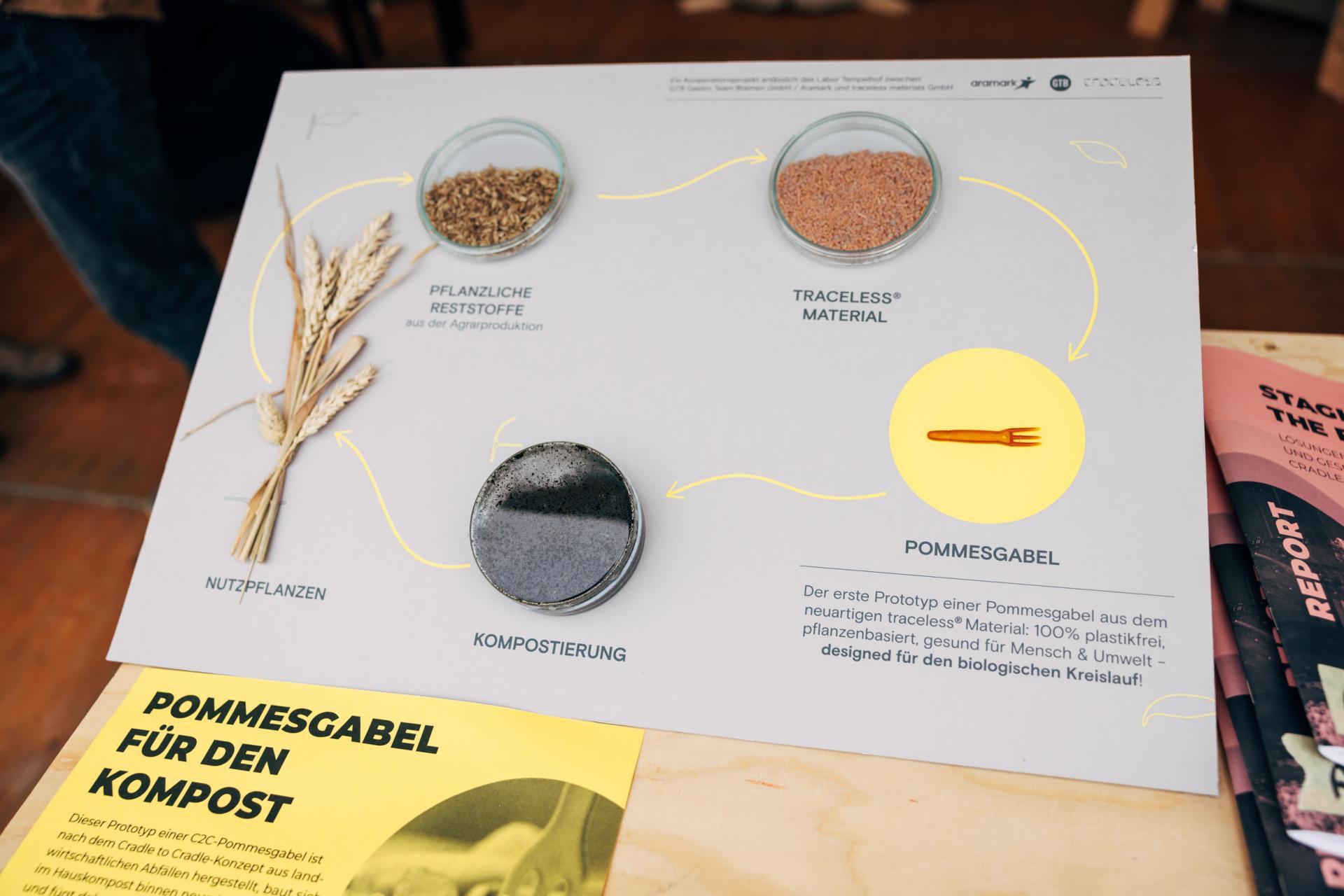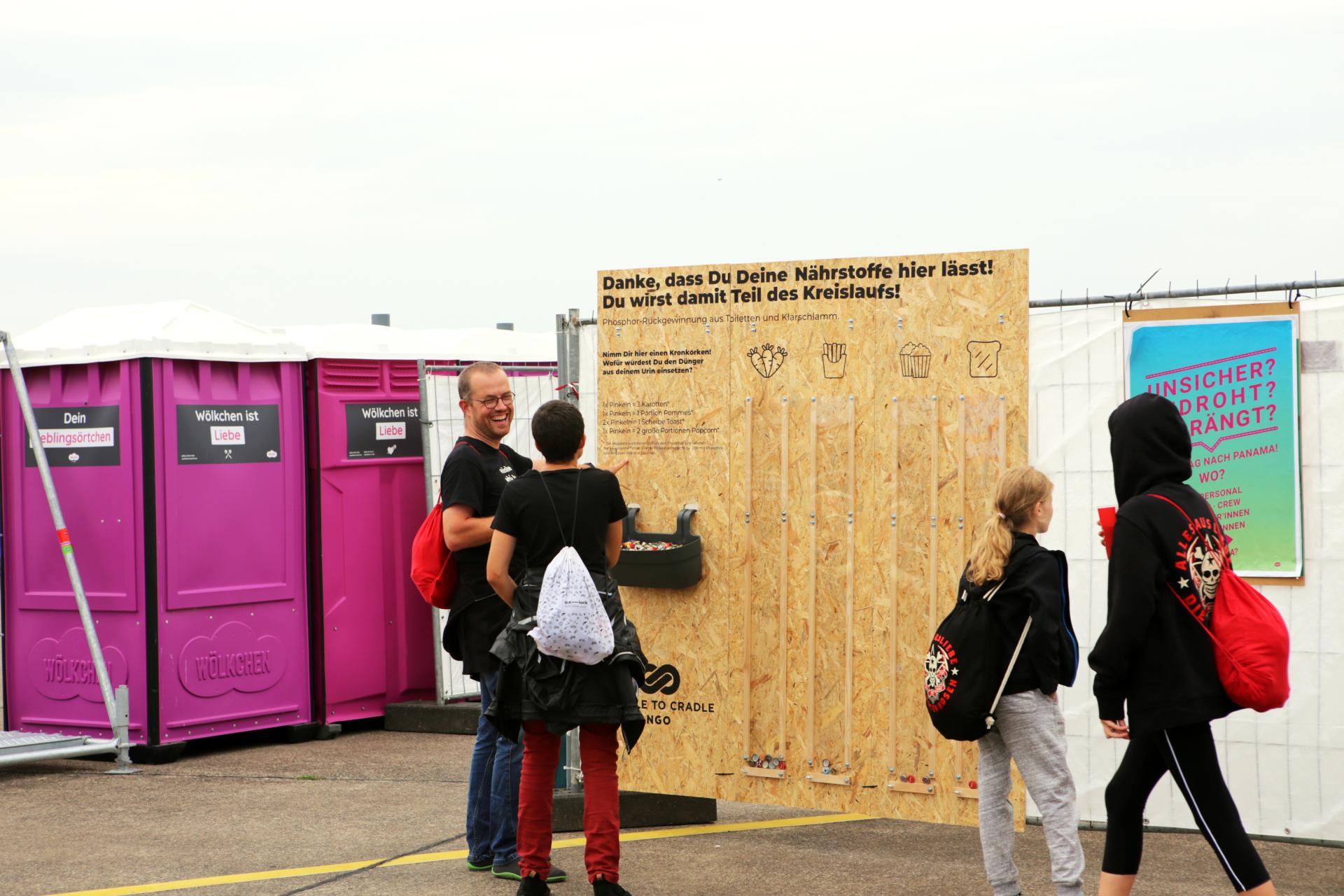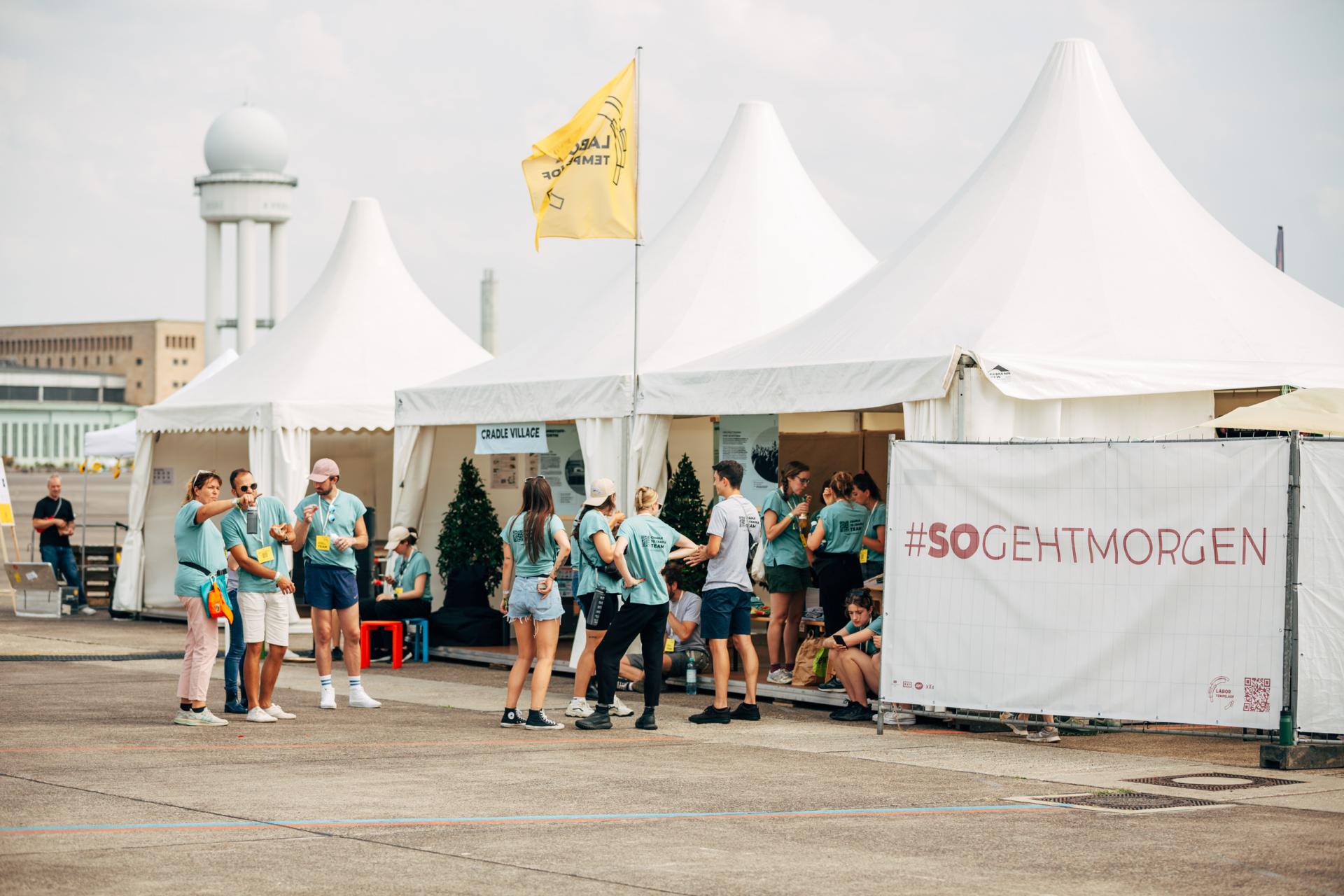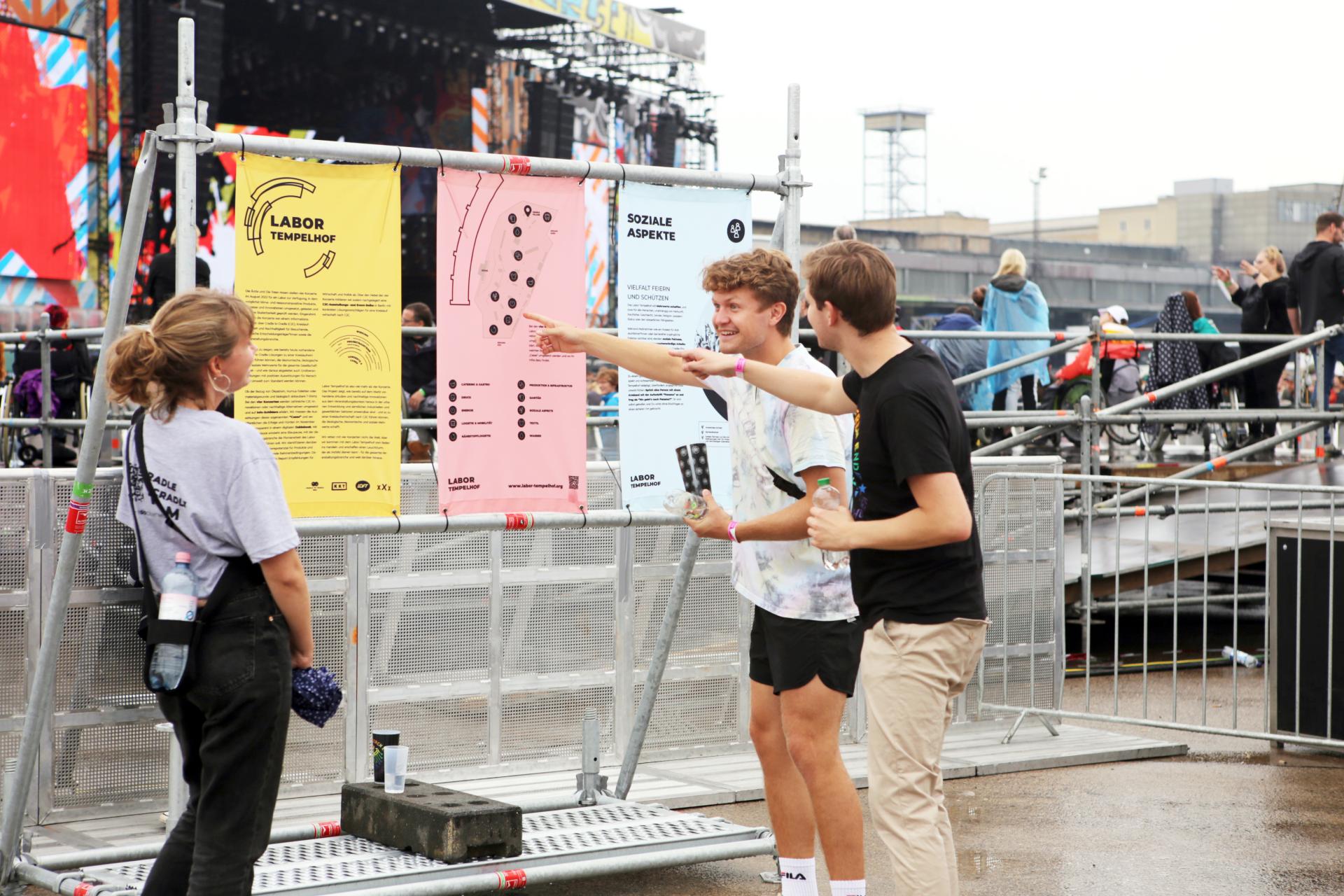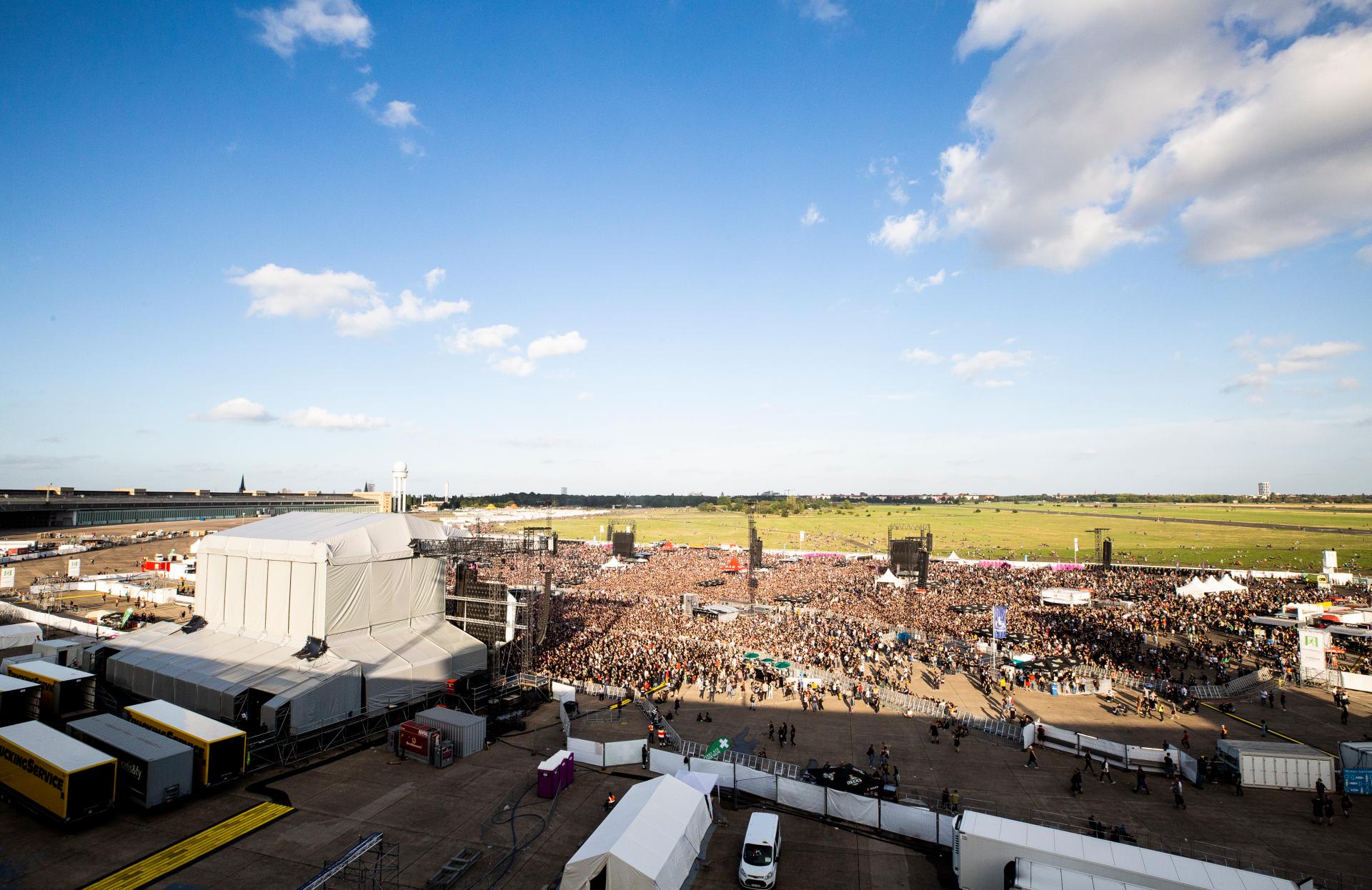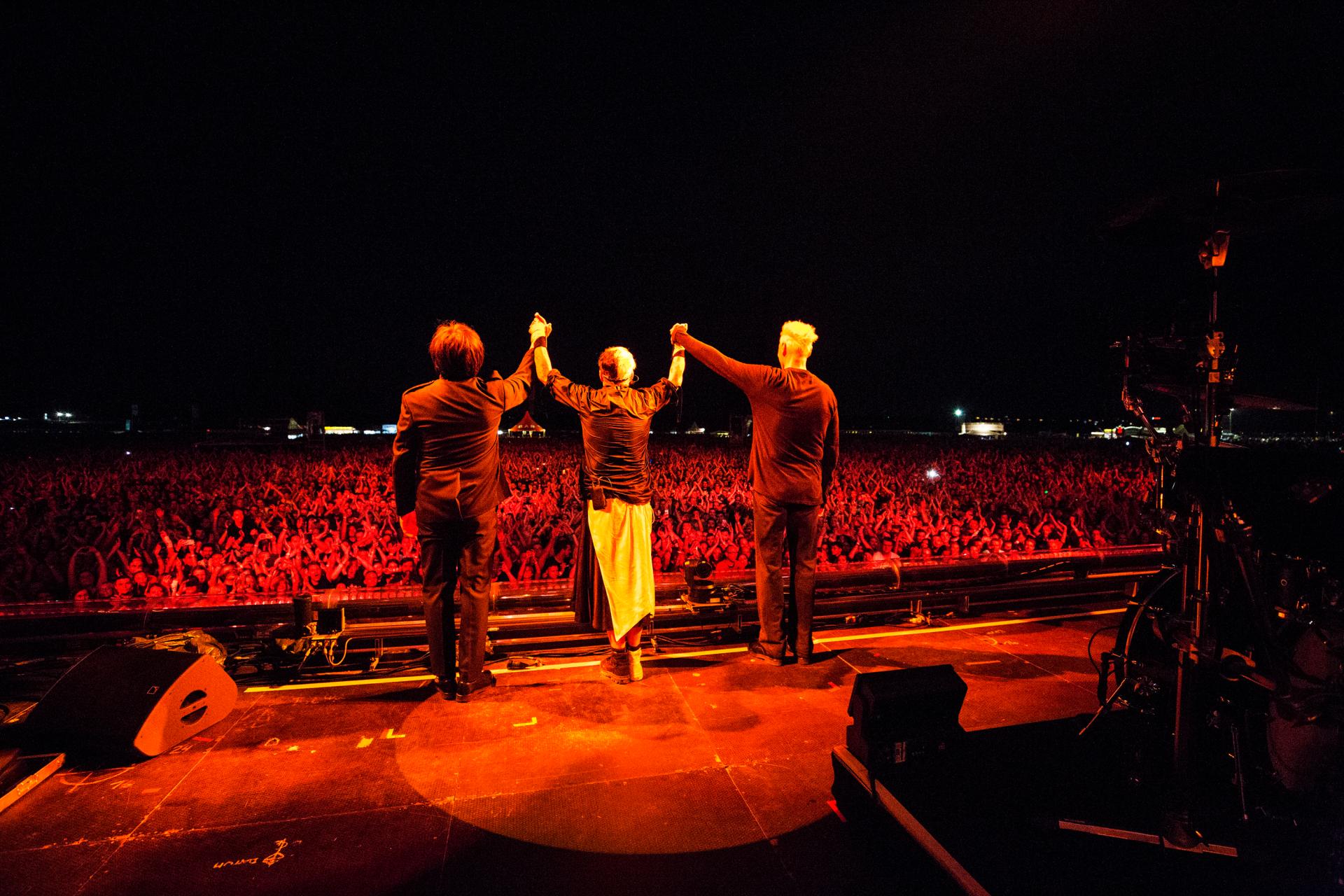Tempelhof Laboratory 2022
Basic information
Project Title
Tempelhof Laboratory 2022
Full project title
Tempelhof Laboratory 2022
Category
Shaping a circular industrial ecosystem and supporting life-cycle thinking
Project Description
Tempelhof Laboratory is an innovative, multi-disciplinary project addressing global challenges through sustainable urban development based on four open air concerts by two of the most famous german rock bands. Pioneering climate change mitigation, circular economy principles, biodiversity conservation, and cross-sector collaboration, the project serves as a scalable model for transforming urban spaces globally.
Geographical Scope
National
Project Region
Germany
Urban or rural issues
Mainly urban
Physical or other transformations
It refers to a physical transformation of the built environment (hard investment)
EU Programme or fund
No
Description of the project
Summary
Tempelhof Laboratory addresses sustainability in the event sector and beyond that in the field of urban development. It tackles the challenge of transforming an emission- and ressource-intensive sector towards sustainable, climate-positive processes and outcomes. This is done by applying Cradle to Cradle (C2C) design principles in practical cases. These cases came about in the collective effort of Cradle to Cradle NGO, two internationally successful German bands “Die Ärzte” and “Die Toten Hosen” and major event companies. Together, they implemented climate- and resource-beneficial products, processes, and innovations in the event sector to test their scalability and contribute to an overall transition into a Circular Economy (CE).
This was carried out in a multi-phased project over 3 years up to now and still ongoing with around 100 partners for four concerts in Berlin, Germany, with three times 60.000 visitors each in 2022 (originally planned for 240,000). The aim was to look at existing solutions through the lens of the Cradle to Cradle school of thought and explore how these can support a genuine circular economy that offers ecological, environmental, and social added value for society as a whole. The long-term goal is to find out how events can impact people and the environment positively and how this can become the norm and change our urban spaces.
Conceived as a laboratory, potential solutions were allowed to fail during the concerts, to deduce which market barriers and hurdles still exist and which conditions and structures are needed in the future. By implementing the first major events with an entirely different approach towards using finite resources and closing resource loops, a beacon was created as a model for the event sector and beyond. Despite being a local endeavor, the effects span regionally and nationally under scope 3 perspective throughout the value chains and continue to spread through post-concert activities.
Key objectives for sustainability
The project is exemplary for the event industry and beyond, as it showcased a path where all the parties involved took comprehensive measures to inform, inspire and empower others.
As a laboratory we tested case studies such as 100% renewable energies by mini-power plants with vegetable oil just for the emergency (would have been decarbonised but were not necessary), introducing the idea of phosphorus recovery and its transformation to fertilizer via special toilets, offering compostable merchandise shirts, and implementing plant-based food for crew and visitors. A coherent campaign on site informed visitors and other stakeholders about the measures and all those who could not be there via extensive publications and information on an online platform.
But the impact of the project extends far beyond the concerts; they were merely the starting point for our initiative. Our approach from the outset was to translate the results into other contexts, aiming for the contexts to achieve the maximum possible outcome. The concerts served as a catalyst, and our goal was always to transform the world beyond the concert grounds. It was very important to us to make all the results freely accessible (open source) in order to encourage as many stakeholders as possible to follow suit.
An open source digital guidebook summarizes the findings and offers easily comprehensible access to all generated data such as measured impact, implemented innovations, missed opportunities and challenges. The guidebook empowers event industry players to build on the project’s insights. An additional campaign outlines formats to bring the project into wider public perception, such as advocating for political awareness with a report for policy makers to adjust conditions to favor circular solutions. Two specialist conferences for further discussions, twelve events and a four-month long exhibition aim to also anchor the learnings within civil society.
As a laboratory we tested case studies such as 100% renewable energies by mini-power plants with vegetable oil just for the emergency (would have been decarbonised but were not necessary), introducing the idea of phosphorus recovery and its transformation to fertilizer via special toilets, offering compostable merchandise shirts, and implementing plant-based food for crew and visitors. A coherent campaign on site informed visitors and other stakeholders about the measures and all those who could not be there via extensive publications and information on an online platform.
But the impact of the project extends far beyond the concerts; they were merely the starting point for our initiative. Our approach from the outset was to translate the results into other contexts, aiming for the contexts to achieve the maximum possible outcome. The concerts served as a catalyst, and our goal was always to transform the world beyond the concert grounds. It was very important to us to make all the results freely accessible (open source) in order to encourage as many stakeholders as possible to follow suit.
An open source digital guidebook summarizes the findings and offers easily comprehensible access to all generated data such as measured impact, implemented innovations, missed opportunities and challenges. The guidebook empowers event industry players to build on the project’s insights. An additional campaign outlines formats to bring the project into wider public perception, such as advocating for political awareness with a report for policy makers to adjust conditions to favor circular solutions. Two specialist conferences for further discussions, twelve events and a four-month long exhibition aim to also anchor the learnings within civil society.
Key objectives for aesthetics and quality
A positive mindset, creative problem-solving processes and diversity lie at the heart of the C2C concept. Music in particular holds the potential to create strong identification with the artists’ values. Together with the cultural sector’s emphasis on aesthetics, Tempelhof Laboratory’s concerts were designed to be sustainable and a beautiful, emotional experience with the visitors’ wellbeing and joy as the focus.
Against the backdrop of Tempelhof airfield and its brutalist architecture this project transformed the concerts into a colorful and inviting space for all and shows how existing and historically significant sites, including those protected as cultural landmarks, can be adapted for future needs. An information concept based in a “Cradle Village” spread across the venue to educate visitors and service providers on how the measures contribute to a concert experience without the need for a bad conscience and foster discussions before, in between and after the concerts. Multicolored informational banners illustrated the on-site measures, where the banners themselves from the fabric, supporting structures down to the utilized ink were composed of healthy and circular materials.
A multitude of the innovative solutions were made aesthetically pleasing for visitors. Out of the box approaches such as phosphorus recovery from the concerts’ toilets was illustrated using a gamified approach. Individuals could vote for the food item that should be grown using the converted fertilizer. Moreover, one hundred ambassadors acted as points of contact for the visitors during the concerts, wearing T-Shirts with an imprinted QR Code leading to further in-depth information on the project.
Changes were made attractive and information accessible to both visitors and service providers. The project highlighted how things had been done in an entirely different way with healthy and circular innovations at the center for a joyful concert experience.
Against the backdrop of Tempelhof airfield and its brutalist architecture this project transformed the concerts into a colorful and inviting space for all and shows how existing and historically significant sites, including those protected as cultural landmarks, can be adapted for future needs. An information concept based in a “Cradle Village” spread across the venue to educate visitors and service providers on how the measures contribute to a concert experience without the need for a bad conscience and foster discussions before, in between and after the concerts. Multicolored informational banners illustrated the on-site measures, where the banners themselves from the fabric, supporting structures down to the utilized ink were composed of healthy and circular materials.
A multitude of the innovative solutions were made aesthetically pleasing for visitors. Out of the box approaches such as phosphorus recovery from the concerts’ toilets was illustrated using a gamified approach. Individuals could vote for the food item that should be grown using the converted fertilizer. Moreover, one hundred ambassadors acted as points of contact for the visitors during the concerts, wearing T-Shirts with an imprinted QR Code leading to further in-depth information on the project.
Changes were made attractive and information accessible to both visitors and service providers. The project highlighted how things had been done in an entirely different way with healthy and circular innovations at the center for a joyful concert experience.
Key objectives for inclusion
Tempelhof Laboratory strives to make learnings and insights as accessible as possible, throughout the planning process, the execution as well as subsequent dissemination of information. The derived insights and learnings were made freely accessible for everyone by publishing it on the project’s website for anyone to educate themselves.
The involved parties aimed to shape the planning and implementation process inclusively. The organizational core team branched out frequently to include the knowledge and opinions of their partners. These experts were included in each case study, ranging from water and sanitation, to food, energy, mobility and waste management. Products utilized were chosen by considering C2C design principles: with a fair production process, using healthy materials and a sustainable handling of soil, water, and air. These criteria have positive long-term effects on whole communities, as illustrated by the bands’ merchandise t-shirt: the organic cotton derives from regenerative agriculture, fair pay and treatment for production workers is maintained and the dying process does not pollute local water streams.
During the concerts, accessibility was combined with sustainability. Public transport was included in the ticket price to encourage the use of trains, trams, and buses, making sustainable travel an affordable choice. On-site elements allowed visitors to have barrier-free access to the stage. A well thought out awareness-concept was applied to provide a safer space for visitors and react to prevailing problematic social dynamics. Briefed personnel were visible via a colored wristband and acted as points of contact for anyone needing assistance.
The project is exemplary because inclusion and accessibility were considered holistically through all organizational stages with a multitude of stakeholders. It was planned, executed, and followed up with an emphasis on transparency, diversity and sustainable social fairness.
The involved parties aimed to shape the planning and implementation process inclusively. The organizational core team branched out frequently to include the knowledge and opinions of their partners. These experts were included in each case study, ranging from water and sanitation, to food, energy, mobility and waste management. Products utilized were chosen by considering C2C design principles: with a fair production process, using healthy materials and a sustainable handling of soil, water, and air. These criteria have positive long-term effects on whole communities, as illustrated by the bands’ merchandise t-shirt: the organic cotton derives from regenerative agriculture, fair pay and treatment for production workers is maintained and the dying process does not pollute local water streams.
During the concerts, accessibility was combined with sustainability. Public transport was included in the ticket price to encourage the use of trains, trams, and buses, making sustainable travel an affordable choice. On-site elements allowed visitors to have barrier-free access to the stage. A well thought out awareness-concept was applied to provide a safer space for visitors and react to prevailing problematic social dynamics. Briefed personnel were visible via a colored wristband and acted as points of contact for anyone needing assistance.
The project is exemplary because inclusion and accessibility were considered holistically through all organizational stages with a multitude of stakeholders. It was planned, executed, and followed up with an emphasis on transparency, diversity and sustainable social fairness.
Results in relation to category
Tempelhof Laboratory has made significant strides in transforming urban development practices, fostering circularity, and promoting a life-cycle approach. The outcomes and impacts of our project resonate across environmental, economic, and social dimensions, benefiting both direct and indirect stakeholders.
Circular Industrial Ecosystem: Our project has successfully implemented circular economy principles within the event sector. This not only lessens the environmental impact but also contributes to the creation of a more resource-efficient and sustainable community.
Economic Benefits: The project has generated indirect beneficiaries by creating economic opportunities within the circular industrial ecosystem, e. g. businesses involved in the case studies have thrived through more visibility and new ideas. The circular economy model adopted by Tempelhof Laboratory has proven to be economically viable, demonstrating that sustainable practices can align with financial prosperity. This will probably lead to a decision by the city to only hold events in this way in the near future.
Environmental Impact: Quantifiable outcomes include a reduction in waste production, lowered carbon emissions, and a more effective use of resources. Through monitoring and assessment, we demonstrated the measurable positive impact of our local circular industrial ecosystem, validating the effectiveness of our life-cycle thinking approach.
Community Empowerment and Education: Direct beneficiaries of our project include the local community, which has experienced tangible benefits in the form of enhanced quality of life. Through the post-concert events and published resources, stakeholders have gained a deeper understanding of the principles of circular economy and life-cycle thinking. This not only empowers individuals to make more sustainable choices but also fosters a sense of collective responsibility for the environment.
Circular Industrial Ecosystem: Our project has successfully implemented circular economy principles within the event sector. This not only lessens the environmental impact but also contributes to the creation of a more resource-efficient and sustainable community.
Economic Benefits: The project has generated indirect beneficiaries by creating economic opportunities within the circular industrial ecosystem, e. g. businesses involved in the case studies have thrived through more visibility and new ideas. The circular economy model adopted by Tempelhof Laboratory has proven to be economically viable, demonstrating that sustainable practices can align with financial prosperity. This will probably lead to a decision by the city to only hold events in this way in the near future.
Environmental Impact: Quantifiable outcomes include a reduction in waste production, lowered carbon emissions, and a more effective use of resources. Through monitoring and assessment, we demonstrated the measurable positive impact of our local circular industrial ecosystem, validating the effectiveness of our life-cycle thinking approach.
Community Empowerment and Education: Direct beneficiaries of our project include the local community, which has experienced tangible benefits in the form of enhanced quality of life. Through the post-concert events and published resources, stakeholders have gained a deeper understanding of the principles of circular economy and life-cycle thinking. This not only empowers individuals to make more sustainable choices but also fosters a sense of collective responsibility for the environment.
How Citizens benefit
As a civil society player, Cradle to Cradle NGO focused on engaging and involving citizens throughout the project and ensuring that their perspective was considered in the process.
On the one hand, volunteers from the region and the German-speaking areas supported the project on-site during the concerts as ambassadors. They received several days of preparation during a separate project module, “Cradle Camp”, where they gained knowledge about the C2C concept, the Laboratory including the concert cases and were able to share their perspectives on the project. This diverse group of around 100 people consisted of long-time enthusiasts as well as first-time volunteers, school and university students, working adults and pensioners - all connected by a passion to share their knowledge and take newly acquired knowledge back to their regions and projects and spread it there.
Aside from the information campaign during the concerts, details about the project were broadcast much further via local and national media, in order to reach citizens in Berlin and nationwide. This set the precedent to involve citizens who did not attend on-site in the post-concert event series. Each event revisits a particular topic from the concerts and takes place in a different district of Berlin in order to involve locals (and others through a online livestream) and pick up discussions about the project’s results and their potential for the urban environment. This is complemented by an interactive exhibition about C2C and sustainable transformation geared towards the general public.
On the one hand, volunteers from the region and the German-speaking areas supported the project on-site during the concerts as ambassadors. They received several days of preparation during a separate project module, “Cradle Camp”, where they gained knowledge about the C2C concept, the Laboratory including the concert cases and were able to share their perspectives on the project. This diverse group of around 100 people consisted of long-time enthusiasts as well as first-time volunteers, school and university students, working adults and pensioners - all connected by a passion to share their knowledge and take newly acquired knowledge back to their regions and projects and spread it there.
Aside from the information campaign during the concerts, details about the project were broadcast much further via local and national media, in order to reach citizens in Berlin and nationwide. This set the precedent to involve citizens who did not attend on-site in the post-concert event series. Each event revisits a particular topic from the concerts and takes place in a different district of Berlin in order to involve locals (and others through a online livestream) and pick up discussions about the project’s results and their potential for the urban environment. This is complemented by an interactive exhibition about C2C and sustainable transformation geared towards the general public.
Physical or other transformations
It refers to a physical transformation of the built environment (hard investment)
Innovative character
Major cultural events have an enormous negative impact on the environment while they have an immense cultural and social value and are also highly relevant from an economic perspective.
In principle, there has never been such a comprehensive and cross-sectoral closed-loop project and the project stands out in particular because Tempelhof Laboratory pioneers an integrated sustainability model by seamlessly blending ecological, economic, and social considerations. Our holistic approach addresses the interconnectedness of global challenges, creating a blueprint for a sustainable future that extends beyond reductionist strategies and fosters new markets for circular products and services.
While many initiatives emphasize sustainability, Tempelhof Laboratory goes a step further by actively shaping a circular industrial ecosystem. The project demonstrates a commitment to circular economy principles by incorporating innovative materials, modular construction, and a life-cycle thinking approach. This goes beyond mere resource efficiency to redefine how urban environments can be developed and sustained over time.
In contrast to conventional top-down approaches, Tempelhof Laboratory is inherently community-driven. Rather than imposing solutions, we engage with and empower the community. This participatory model fosters a sense of ownership and ensures that the project aligns with the unique needs and aspirations of the people it serves.
A circular transformation must include all stakeholders in the process so the sector can adapt and maintain itself. Bringing people together from all branches and trades of the event sector, introducing them to a C2C-perspective and enabling concerts with a positive impact for artists, visitors, organizers, executors and people along the value chains of products and services used - that is the innovative power of Tempelhof Laboratory.
In principle, there has never been such a comprehensive and cross-sectoral closed-loop project and the project stands out in particular because Tempelhof Laboratory pioneers an integrated sustainability model by seamlessly blending ecological, economic, and social considerations. Our holistic approach addresses the interconnectedness of global challenges, creating a blueprint for a sustainable future that extends beyond reductionist strategies and fosters new markets for circular products and services.
While many initiatives emphasize sustainability, Tempelhof Laboratory goes a step further by actively shaping a circular industrial ecosystem. The project demonstrates a commitment to circular economy principles by incorporating innovative materials, modular construction, and a life-cycle thinking approach. This goes beyond mere resource efficiency to redefine how urban environments can be developed and sustained over time.
In contrast to conventional top-down approaches, Tempelhof Laboratory is inherently community-driven. Rather than imposing solutions, we engage with and empower the community. This participatory model fosters a sense of ownership and ensures that the project aligns with the unique needs and aspirations of the people it serves.
A circular transformation must include all stakeholders in the process so the sector can adapt and maintain itself. Bringing people together from all branches and trades of the event sector, introducing them to a C2C-perspective and enabling concerts with a positive impact for artists, visitors, organizers, executors and people along the value chains of products and services used - that is the innovative power of Tempelhof Laboratory.
Disciplines/knowledge reflected
As Tempelhof Laboratory was a joint effort from the beginning, the parties involved (particularly amongst the core team) were all from various backgrounds, which made the project highly interdisciplinary and complex. Stakeholders from diverse sectors, including representatives from science, consultancies, the ngo sector, economic development aid, event industry, politicians and the press, were actively engaged in either the project’s development and oversight. Within the core team there was immense expertise in project management, event organization and logistics, artistic direction, tech and IT and many more. This was complemented by the knowledge of Cradle to Cradle NGO around holistic circularity and practical implementation of C2C.
This meant that various perspectives were involved in both the design and implementation of the project - those of long-time practitioners in the sector and those of external practitioners and strategists providing a framework for circular transformation. The resulting process covered social, economic, ecological and cultural aspects in equal measure and required compromises to accommodate all stakeholders of this participatory process.
In terms of scientific disciplines, the monitoring and evaluation process for the guidebook was supported by Adelphi, a Berlin-based independent think tank and political consultancy with focus on accelerating socio-ecological transformation, and The Boston Consulting Group. They provided expertise on methodology and data analysis as well as knowledge on translating complex information into an easily accessible format. The value of this cooperation was insurmountable, as it ensured that outcomes were measured in a manner that made them comparable with similar projects, mainly based on tracking (non-)emissions.
This meant that various perspectives were involved in both the design and implementation of the project - those of long-time practitioners in the sector and those of external practitioners and strategists providing a framework for circular transformation. The resulting process covered social, economic, ecological and cultural aspects in equal measure and required compromises to accommodate all stakeholders of this participatory process.
In terms of scientific disciplines, the monitoring and evaluation process for the guidebook was supported by Adelphi, a Berlin-based independent think tank and political consultancy with focus on accelerating socio-ecological transformation, and The Boston Consulting Group. They provided expertise on methodology and data analysis as well as knowledge on translating complex information into an easily accessible format. The value of this cooperation was insurmountable, as it ensured that outcomes were measured in a manner that made them comparable with similar projects, mainly based on tracking (non-)emissions.
Methodology used
The aim of the project was to reach new target groups and appeal to people with little to no prior knowledge of C2C and sustainability through the medium of a cultural event - to do so, Tempelhof Laboratory was conceptualized as a multi-layered endeavor.
The initial building block of the project was the circular transformation of the concerts with the individual cases, from water usage to mobility, logistics all the way to food. Finding and implementing sustainable, C2C-solutions for each of these cases together with a multitude of partners was the central approach.
Further building blocks that developed during the process were dissemination activities, e. g. the involvement of civil society via the Cradle Camp and on-site support, the information campaign during the concerts, the public relations work before and after, the report and guidebook as well as the post-concert conferences, event series and exhibition.
The report was written throughout the preparation and development of the concert cases and published in time for the implementation, to involve policy makers early on and incite a shift on the political level to support the societal and economic efforts. The guidebook was conceptualized and data collected during concert preparation and implementation, so the emission assessment results could be published digitally and inspire the event industry by showing how large levers for circularity can be moved. The post-concert events focus on spreading the message to inspire, network, share and discuss knowledge and experiences with event industry stakeholders and interested citizens. This includes a training format to build skills and resources amongst professionals to apply the guidebook’s suggestions in practice. The project has already reached 180,000 people through the concerts alone, through upcoming measures and media coverage we expect to reach at least 500,000 more in Germany and by providing resources in English, additional global audiences.
The initial building block of the project was the circular transformation of the concerts with the individual cases, from water usage to mobility, logistics all the way to food. Finding and implementing sustainable, C2C-solutions for each of these cases together with a multitude of partners was the central approach.
Further building blocks that developed during the process were dissemination activities, e. g. the involvement of civil society via the Cradle Camp and on-site support, the information campaign during the concerts, the public relations work before and after, the report and guidebook as well as the post-concert conferences, event series and exhibition.
The report was written throughout the preparation and development of the concert cases and published in time for the implementation, to involve policy makers early on and incite a shift on the political level to support the societal and economic efforts. The guidebook was conceptualized and data collected during concert preparation and implementation, so the emission assessment results could be published digitally and inspire the event industry by showing how large levers for circularity can be moved. The post-concert events focus on spreading the message to inspire, network, share and discuss knowledge and experiences with event industry stakeholders and interested citizens. This includes a training format to build skills and resources amongst professionals to apply the guidebook’s suggestions in practice. The project has already reached 180,000 people through the concerts alone, through upcoming measures and media coverage we expect to reach at least 500,000 more in Germany and by providing resources in English, additional global audiences.
How stakeholders are engaged
The knowledge and results from Tempelhof Laboratory are intended for everyone organizing and making events possible as well as those who attend. To accurately depict real-life circumstances, multiple stakeholders were involved at different points in the process: from stage construction, artists and their management, merchandise producers, catering, technical suppliers, mobility providers, logistics services, sanitary facilities, energy providers and many more.
Some of them were new to the C2C concept, some engaged with the topic in order to be part of the project and some indirectly engaged due to being recruited - thus resulting in a valuable dialogue and reflection process about the products and services. The majority were involved either in knowledge transfer, informal interactions, business partnerships or advisory work. For certain cases, stakeholders were also involved on a national and international level, e. g. in the area of C2C-merchandising. This resulted in higher awareness for available circular options amongst all stakeholders but also spread news of the project into different parts of Germany and neighboring countries through their respective networks.
The involvement of regional, national and even international policy makers and players was also decisive, both through their attendance of an on-site tour on the concert days and at post-concert events discussing the project’s implication. This has resulted in the political framework required for a circular shift in the event sector being addressed in national policy.
Importantly, the local, regional and national levels were all represented through the concert visitors. This essential stakeholder group engaged with the information campaign and supported project implementation by using the C2C-solutions on-site, thereby testing their applicability and generating data for the impact evaluation.
Some of them were new to the C2C concept, some engaged with the topic in order to be part of the project and some indirectly engaged due to being recruited - thus resulting in a valuable dialogue and reflection process about the products and services. The majority were involved either in knowledge transfer, informal interactions, business partnerships or advisory work. For certain cases, stakeholders were also involved on a national and international level, e. g. in the area of C2C-merchandising. This resulted in higher awareness for available circular options amongst all stakeholders but also spread news of the project into different parts of Germany and neighboring countries through their respective networks.
The involvement of regional, national and even international policy makers and players was also decisive, both through their attendance of an on-site tour on the concert days and at post-concert events discussing the project’s implication. This has resulted in the political framework required for a circular shift in the event sector being addressed in national policy.
Importantly, the local, regional and national levels were all represented through the concert visitors. This essential stakeholder group engaged with the information campaign and supported project implementation by using the C2C-solutions on-site, thereby testing their applicability and generating data for the impact evaluation.
Global challenges
Tempelhof Laboratory, with its innovative and locally grounded solutions, addresses critical global challenges, embodying the concept of thinking globally and acting locally. The project's comprehensive approach confronts climate change, resource depletion, social inequalities, and the imperative for sustainable urban development.
1. Climate Change Mitigation: Tempelhof Laboratory serves as a model for effective climate change mitigation. Through the integration of renewable energy sources, energy-efficient technologies, and water-conserving practices, the project significantly contributes to reducing carbon emissions. This aligns with broader climate action goals, demonstrating the pivotal role urban environments play in combating global climate challenges.
2. Circular Economy and Resource Management: At the forefront of addressing resource depletion, the project pioneers circular economy principles. By repurposing existing structures, employing sustainable materials, and adopting a life-cycle thinking approach, Tempelhof Laboratory minimizes waste generation and promotes efficient resource use. This localized solution sets an example for responsible resource management applicable globally across various industries.
3. Biodiversity Conservation and Green Spaces: Confronting the global challenge of biodiversity loss, Tempelhof Laboratory integrates green spaces into its urban design, promoting biodiversity and enhancing the integrity of the local biosphere. The project underscores the significance of incorporating nature into urban environments, establishing a precedent for sustainable urban planning prioritizing ecosystem preservation.
4. Cross-Sector Collaboration and Knowledge Transfer: By fostering an environment that transcends traditional boundaries and sharing the collaborative process, the project promotes cross-sectoral collaboration that can be replicated globally.
1. Climate Change Mitigation: Tempelhof Laboratory serves as a model for effective climate change mitigation. Through the integration of renewable energy sources, energy-efficient technologies, and water-conserving practices, the project significantly contributes to reducing carbon emissions. This aligns with broader climate action goals, demonstrating the pivotal role urban environments play in combating global climate challenges.
2. Circular Economy and Resource Management: At the forefront of addressing resource depletion, the project pioneers circular economy principles. By repurposing existing structures, employing sustainable materials, and adopting a life-cycle thinking approach, Tempelhof Laboratory minimizes waste generation and promotes efficient resource use. This localized solution sets an example for responsible resource management applicable globally across various industries.
3. Biodiversity Conservation and Green Spaces: Confronting the global challenge of biodiversity loss, Tempelhof Laboratory integrates green spaces into its urban design, promoting biodiversity and enhancing the integrity of the local biosphere. The project underscores the significance of incorporating nature into urban environments, establishing a precedent for sustainable urban planning prioritizing ecosystem preservation.
4. Cross-Sector Collaboration and Knowledge Transfer: By fostering an environment that transcends traditional boundaries and sharing the collaborative process, the project promotes cross-sectoral collaboration that can be replicated globally.
Learning transferred to other parties
It is possible for the concerts themselves to be replicated in the same form but more importantly, the results of the project - being widely accessible as open source and open innovation - can be replicated in similar settings and be applied to other events in urban settings. C2C provides a tool box of processes and a concept that can be transmitted and applied in every sector and can be adapted to regional and structural circumstances.
This was the intention of Tempelhof Laboratory all along - to inspire other artists, production companies and cultural institutions to follow the example and emulate similar solutions that fit their particular setting. Since cultural events reach a wide and diverse audience and therefore a large portion of civic society, the potential positive impact of transferring solutions from Tempelhof Laboratory to other events is extremely high as we have already presented the project at various conferences and events in the cultural sector and beyond. Whether the impulse is given by artists or by organizers and production companies - fostering collaboration to make events sustainable by going circular is made simple through the resources that have been produced throughout the project, such as the website, report and guidebook.
Concrete case studies that have high chances of replication or transfer include providing plant-based foods, changing merchandise production, switching to renewable energy sources, collecting and sorting waste, reusing water in sanitation context, moving away from non-recyclable materials for infrastructure, giving incentives for sustainable mobility and ensuring access for different social groups. No matter what event in which region of the world: it is about asking the right questions, uncovering occurring resource challenges and thus finding individual solutions for them. The resources from the project provide these questions and help to apply them according to individual purposes and needs.
This was the intention of Tempelhof Laboratory all along - to inspire other artists, production companies and cultural institutions to follow the example and emulate similar solutions that fit their particular setting. Since cultural events reach a wide and diverse audience and therefore a large portion of civic society, the potential positive impact of transferring solutions from Tempelhof Laboratory to other events is extremely high as we have already presented the project at various conferences and events in the cultural sector and beyond. Whether the impulse is given by artists or by organizers and production companies - fostering collaboration to make events sustainable by going circular is made simple through the resources that have been produced throughout the project, such as the website, report and guidebook.
Concrete case studies that have high chances of replication or transfer include providing plant-based foods, changing merchandise production, switching to renewable energy sources, collecting and sorting waste, reusing water in sanitation context, moving away from non-recyclable materials for infrastructure, giving incentives for sustainable mobility and ensuring access for different social groups. No matter what event in which region of the world: it is about asking the right questions, uncovering occurring resource challenges and thus finding individual solutions for them. The resources from the project provide these questions and help to apply them according to individual purposes and needs.
Keywords
Cradle to Cradle
Circular shift
Climate beneficial
Future-oriented events
Urban future

